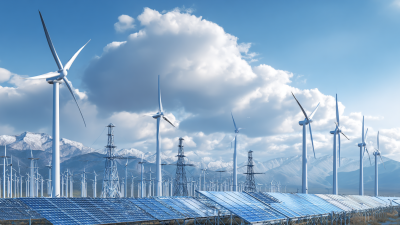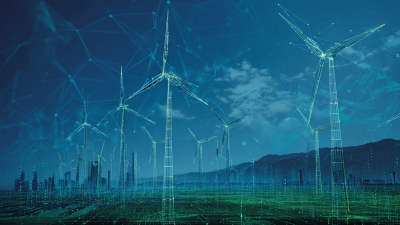Harnessing Power Energy for a Sustainable Future The Role of Renewable Sources in Global Energy Consumption
As the world grapples with the pressing challenges of climate change and environmental degradation, the quest for sustainable solutions has never been more critical. Harnessing power energy through renewable sources emerges as a pivotal strategy in the global energy landscape. This shift towards renewables not only addresses the urgent need to reduce greenhouse gas emissions but also promotes energy security and economic resilience.

With fossil fuels contributing significantly to global warming, alternative sources such as solar, wind, and hydroelectric power are becoming increasingly vital. This article delves into the various dimensions of how renewable power energy contributes to global energy consumption, exploring its technological advancements, economic implications, and the transformative potential it holds for creating a more sustainable future.
By understanding the role of renewable energy in shaping our energy systems, we can better navigate the path towards a cleaner, greener planet.
The Importance of Renewable Energy in Mitigating Climate Change
Renewable energy plays a pivotal role in combating climate change, as it directly contributes to reducing greenhouse gas emissions. According to the International Renewable Energy Agency (IRENA), transitioning to renewable sources could help cut emissions by up to 70% by 2050. This is crucial, as the Intergovernmental Panel on Climate Change (IPCC) reports that limiting global warming to 1.5 degrees Celsius requires a significant reduction in carbon emissions, with renewables providing the clean energy needed.
As we embrace a greener future, individuals and businesses alike can take steps to incorporate renewable energy into their routines.
Tip: Consider installing solar panels or opting for wind energy through your local utility provider. Such small changes not only reduce your carbon footprint but also support the larger shift towards sustainable energy consumption.
Moreover, investments in renewables are at an all-time high, with global renewable energy capacity reaching over 3,000 gigawatts in 2020. This shift is supported by favorable policies and innovations that drive down costs.
Tip: Stay informed about government incentives for renewable energy installations; taking advantage of these can significantly lower initial costs and enhance energy efficiency in your home or business.

Key Renewable Energy Sources and Their Global Impact
As the world shifts towards sustainability, renewable energy sources play a crucial role in shaping a greener future. Recent studies indicate that global investment in solar energy is expected to surge from $25.69 billion in 2023 to a staggering $436.36 billion by 2032, showcasing a compound annual growth rate of 6%. This pivotal growth underscores the significant contribution of renewable sources to reducing carbon emissions and promoting cleaner production methods in global trade.
Tips: Investing in renewable energy not only mitigates climate change impacts but also enhances energy independence. Countries are urged to develop precise accounting for renewable energy flows within global supply chains to better inform trade practices.
The transition to a 40% share of clean electricity globally highlights the accelerating shift towards renewables, particularly in regions like China, which is leading the charge with substantial contributions from wind and solar energy. However, challenges remain, such as the need for reliable energy systems and the integration of weather insights for efficient supply planning. The focus must be on harnessing these renewable resources effectively to meet future energy demands while pursuing net-zero emission goals.
Technological Innovations Driving Renewable Energy Adoption
Technological innovations play a pivotal role in accelerating the adoption of renewable energy sources, significantly shaping the landscape of global energy consumption. Advancements in solar panel efficiency, for instance, have made it possible to harness sunlight more effectively, thereby reducing costs and increasing energy output. The integration of smart grid technology enhances the management and distribution of renewable energy, facilitating a more reliable and efficient energy supply. As these technologies develop, they help overcome traditional barriers to renewable energy deployment, making it an increasingly viable alternative to fossil fuels.
Moreover, innovations in energy storage solutions, such as lithium-ion batteries and emerging solid-state technologies, are crucial for addressing the intermittency issues associated with renewable sources like wind and solar power. These storage systems allow for the capture and release of energy, ensuring a constant supply regardless of weather conditions. By providing a scalable and adaptable energy infrastructure, these technological advancements empower individuals and communities to transition towards a more sustainable future, significantly reducing greenhouse gas emissions and promoting energy independence on a global scale.
Harnessing Power Energy for a Sustainable Future
| Renewable Energy Source | Global Consumption in 2022 (TWh) | Percentage of Total Energy Consumption (%) | Technological Innovations |
|---|---|---|---|
| Solar Energy | 1,200 | 18.5% | Photovoltaic cells, Solar thermal technology |
| Wind Energy | 800 | 12.3% | Turbine efficiency improvements, Offshore wind technology |
| Hydropower | 4,000 | 61.5% | Small-scale hydro, Pumped storage technology |
| Biomass | 200 | 3.1% | Biofuels production, Waste to energy technologies |
| Geothermal | 100 | 1.5% | Enhanced geothermal systems, Binary cycle power plants |
Challenges and Opportunities in Transitioning to Renewable Energy
The transition to renewable energy is both a challenge and an opportunity that requires careful consideration and action. According to the International Energy Agency (IEA), global energy demand is projected to rise by 30% by 2040, necessitating a shift toward more sustainable sources. However, this transition faces significant hurdles, including technological limitations, infrastructure deficits, and regulatory frameworks that are often slow to adapt. For instance, the deployment of solar and wind energy has surged, with renewable sources accounting for 29% of global electricity generation in 2020, yet achieving full potential demands overcoming storage and grid adaptability issues.
Simultaneously, the shift presents numerous opportunities. The International Renewable Energy Agency (IRENA) reported that transitioning to renewables could create over 24 million jobs worldwide by 2030, engaging a substantial workforce in installation, maintenance, and innovation sectors. As countries commit to net-zero goals, investments in renewable technologies, energy efficiency, and electrification are expected to surge, which could catalyze economic growth and enhance energy security. By addressing the inherent challenges, such as financing and technological advancements, the global community can harness the full potential of renewable energy to pave the way for a sustainable future.
Future Trends in Global Energy Consumption and Sustainability
The global energy landscape is undergoing a significant transformation as the demand for sustainability continues to rise. Future trends indicate an increasing reliance on renewable energy sources, such as solar, wind, and hydropower, which offer cleaner alternatives to fossil fuels. As countries commit to reducing carbon emissions, it's imperative for industries and consumers alike to embrace energy-efficient practices that align with these environmental goals.
**Tips**: To contribute to a sustainable future, consider adopting renewable energy solutions at home, such as solar panels. Additionally, improving energy efficiency in everyday activities, like using energy-saving appliances and reducing water usage, can significantly lower your carbon footprint.
Moreover, advancements in technology are paving the way for more efficient energy consumption. Innovations in smart grids and energy storage systems are enhancing the effectiveness of renewable resources, enabling better management of energy supply and demand. As these technologies advance, the shift towards a sustainable energy future becomes not only achievable but also economically viable for all.
**Tips**: Stay informed about the latest developments in renewable technologies and consider participating in local green initiatives. Engaging with community programs focused on sustainability can amplify your impact and foster a collective approach towards a greener planet.

Related Posts
-

Exploring Sustainable Energy Innovations at 2025 China 138th Canton Fair
-

Exploring Alternative Energy Innovations at the 138th Canton Fair 2025: A Data-Driven Insight
-

Harnessing Smart Grid Energy Innovations at the 2025 China Import and Export Fair
-

What is Energy Solutions and How They Impact Global Sustainability Efforts
-

Harnessing Wind Energy for a Sustainable Future Beyond Fossil Fuels
-

Wind Farm Energy Innovations at 2025 China Import and Export Fair: Harnessing a $1 Trillion Industry

